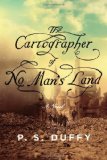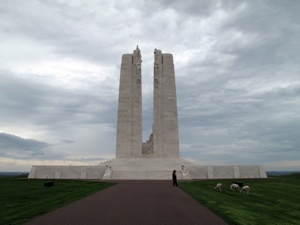Summary | Excerpt | Reading Guide | Reviews | Beyond the Book | Read-Alikes | Genres & Themes | Author Bio

Critics' Opinion:
Readers' Opinion:
First Published:
Oct 2013, 384 pages
Paperback:
Oct 2013, 384 pages
 Book Reviewed by:
Book Reviewed by:
Kim Kovacs
Buy This Book
This article relates to The Cartographer of No Man's Land
In her introduction to The Cartographer of No Man's Land, P.S. Duffy states that the WWI Battle of Vimy Ridge is "as iconic to Canadians as Bunker Hill is to Americans."
The Canadian Expeditionary Force (CEF) was formed in 1914 to provide support to the British battling overseas. 619,363 Canadians enlisted, of whom 60,661 – nearly 10% - were killed or wounded. The CEF was instrumental in many important actions, including The Battle of Ypres (1915), The Battle of the Somme (July – November, 1916), and Passchendaele (November 1917). The group was very well-regarded, and members of the CEF were considered among the fiercest fighters.
Vimy Ridge is a 4.3 mile long escarpment about 5 miles northeast of the French town of Arras. While not terribly high at only 200 feet above the surrounding plains, it provides a commanding view in all directions, making it a key strategic objective in military maneuvers. German forces seized control of it in September 1914, and heavily fortified it with bunkers, caves, artillery-proof trenches and concrete machine gun emplacements. From this position they were able to bombard the Allies in Arras.
The French tried to regain control of the ridge during the remainder of 1914 and throughout 1915, but these attempts failed miserably, with approximately 150,000 French troops wounded or killed. British offensives made during the early months of 1916 were also unsuccessful, leading many to state that re-taking Vimy Ridge was not possible. Nevertheless, the British began planning a new offensive in May 1916, which was finalized in March the following year. The CEF would be put under control of British General Julian Byng to retake the ridge, the first battle in which all four divisions of the CEF would fight together. The British 5th Infantry Division would provide support. Preparation included making sure adequate artillery was available; training rank and file soldiers to take over should their commanders be killed or wounded; and digging miles upon miles of tunnels, allowing the troops to advance to the Front while keeping out of sight of the German army.
 Three weeks before the battle, the British began bombing the German positions night and day with heavy artillery. The raid was scheduled for April 8 – Easter Sunday – but was delayed by weather. The following morning at 5:30, the action began with artillery fire and the detonation of mines, which had been stealthily planted underneath German positions. The Canadians advanced under heavy fire, and within half an hour the 1st Division succeeded in capturing German front line positions, with the second line falling a mere 30 minutes after that. Sporadic fighting continued until April 12, when the highest point on the ridge fell to CEF forces. The operation was deemed a spectacular success, and Vimy Ridge remained under Allied control for the remainder of the war. Taking the ridge was not without cost, however: 3,598 CEF troops were killed and 7,004 were wounded, while the Germans suffered approximately 20,000 casualties.
Three weeks before the battle, the British began bombing the German positions night and day with heavy artillery. The raid was scheduled for April 8 – Easter Sunday – but was delayed by weather. The following morning at 5:30, the action began with artillery fire and the detonation of mines, which had been stealthily planted underneath German positions. The Canadians advanced under heavy fire, and within half an hour the 1st Division succeeded in capturing German front line positions, with the second line falling a mere 30 minutes after that. Sporadic fighting continued until April 12, when the highest point on the ridge fell to CEF forces. The operation was deemed a spectacular success, and Vimy Ridge remained under Allied control for the remainder of the war. Taking the ridge was not without cost, however: 3,598 CEF troops were killed and 7,004 were wounded, while the Germans suffered approximately 20,000 casualties.
In 1920, the Imperial War Graves Commission awarded Canada land on which to erect memorials to their war dead, including 250 acres at Vimy Ridge. A design submitted by Canadian sculptor Walter Seymour Allward was selected and work began in 1925. The completed monument was unveiled in July 1936 by Britain's short-lived King Edward VIII (in his capacity as King of Canada). The dedication was attended by French President Albert Lebrun as well as over 50,000 veterans and their families. Restoration of the monument took place in 2001-2004 and it was rededicated by Queen Elizabeth II on the 90th anniversary of the battle.
Picture of Vimy Ridge Memorial from Commonwealth War Graves Commission
Filed under People, Eras & Events
![]() This article relates to The Cartographer of No Man's Land.
It first ran in the November 6, 2013
issue of BookBrowse Recommends.
This article relates to The Cartographer of No Man's Land.
It first ran in the November 6, 2013
issue of BookBrowse Recommends.





The Flower Sisters
by Michelle Collins Anderson
From the new Fannie Flagg of the Ozarks, a richly-woven story of family, forgiveness, and reinvention.

The House on Biscayne Bay
by Chanel Cleeton
As death stalks a gothic mansion in Miami, the lives of two women intertwine as the past and present collide.

The Funeral Cryer by Wenyan Lu
Debut novelist Wenyan Lu brings us this witty yet profound story about one woman's midlife reawakening in contemporary rural China.
Your guide toexceptional books
BookBrowse seeks out and recommends the best in contemporary fiction and nonfiction—books that not only engage and entertain but also deepen our understanding of ourselves and the world around us.